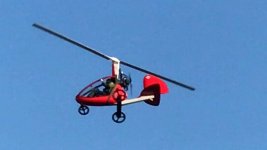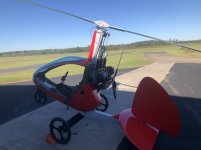-+
I've asked several people the question of how similar or different gyros fly. Could you point out some of the different gyros you've flown and what differences they had, especially the extremes? The gyro with the biggest differences I've noted is the Magni with the very heavy stick, and the big difference between open and faired gyros with how much aerodynamic difference they can make.
That is a big question John.
My advice is to follow the pilot’s operating handbook if you have one.
Based on my experience:
A high thrust line gyroplane will nose up when power is reduced and nose down when power is increased.
A low thrust line gyroplane will nose down when power is reduced and nose up when power is added.
Most Rotax 9 series gyroplanes with a short vertical stabilizer/ rudder will yaw right when power is reduced and left when power is added.
A side by side is generally less pitch and yaw stable than a tandem because of the lower polar moment and control configuration.
An offset gimbal rotor head needs increased back pressure as the bank increases to maintain altitude.
A spindle head gives less feedback and generally speaking requires more attention.
The various nose wheel steering systems may be more or less sensitive to pedal input and have more or less self-centering depending on the design.
A properly setup nose wheel steering in no wind conditions will not get the wiggles when you touch it back down when taking off.
The location of the mains has a lot to do with how a gyroplane lifts off.
A tail wheel gives you options on landing that are absent without a tail wheel.
In my opinion with most gyroplanes I have flown if I touch the tail wheel on takeoff the nose is too high and she will lift off at a lower indicated airspeed than is desirable and ridding the tail wheel is a bad habit to get into.
Most of the gyroplanes I have flown like to have the nose wheel less than an inch off the ground during the takeoff roll. Again, read the POH.
How a gyroplane reacts when it is landed hard varies considerably.
Some give all the energy back, some will just settle in and some have no suspension at all.
The more drag a gyroplane has the faster it will descend when power is reduced. This is particularly noticeable comparing a Calidus to an MTO.
The various trim systems have different feels.
The pre-rotation scheme is different for different gyroplane and again follow the POH.
Some gyroplane blades are easier to sail than others.
Sailing a blade is all about too much indicated air speed for the rotor rpm.
I am off to teach, I may add to this when I re-read it tonight.
This is not an invitation to debate as this is based on my experience.
If someone has had a different experience please elaborate to broaden everyone’s experience.
I like every gyroplane I have flown and am not denigrating a particular design.


